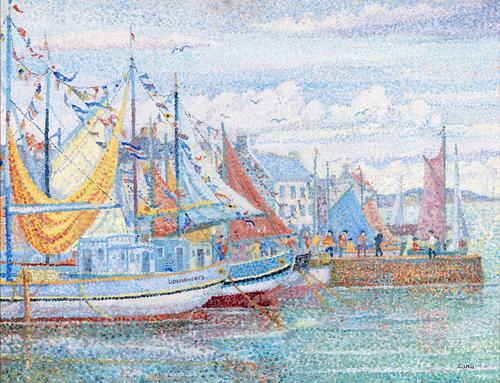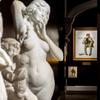Yvonne Canu: Devotee of Pointillism
- March 06, 2022 11:42


Yvonne Canu was a 20th-century French Post-Impressionist who became a devotee of Pointillism more than a half-century after its originator’s death. So entranced by her first up-close experience with Georges Seurat’s work, she found her purpose as an artist as a student of his revolutionary style. Canu’s pointillist creations are distinctly modern, rendered with painstakingly precise dots of pure color that brilliantly blend together to form a cohesive work of art. Although her paintings indeed display the influence of Seurat in both their technique and choice of subject, her style is nevertheless distinctive. Colorful and avant-garde, her works are a testament to the utter freedom of creativity the artist enjoyed.
The public knows Pointillism as the creation of the Post-Impressionist icon Georges Seurat, and he served as Canu’s most significant influence. By the time Seurat began his studies in this new movement, the Impressionists had already made waves in the art world, dismantling traditional ideas of color, form and atmosphere. Seurat, however, wanted to take the Impressionists’ innovative style a step further in an effort to bring together art and science. This led him to what would become known as Pointillism, which was based on the theory of optical mixture by the division of tones.
Seurat set to work on his first great masterpiece, Bathers, Asnières, in 1883; it was during this period that he also met the 100-year-old chemist Michel-Eugène Chevreul, from whom he learned about complementary color theories. In 1824, Chevreul was appointed director of dye works at the Gobelins Manufactory, a historic tapestry factory in Paris. The company believed their fabric dyes were too weak and charged the chemist with finding a solution. Chevreul discovered that certain colors, like black, appeared weak and reddish when surrounded by deep blues or purples, concluding that the human eye perceives hue and value differently based on the colors that surround it. Essentially, the juxtaposition of complementary colors intensifies the color of both. Seurat used this scientific understanding of color to experiment and revolutionize color theory in painting.
Using dots of contrasting and complementary color, Seurat substituted an optical mixture of colors in lieu of mixing pigments on a palette. When viewed from afar, his dots of red and blue became purple and yellow and red became orange. His mathematical exactitude and technical precision were breaking new ground in painting. The results, according to artist Camille Pissarro, were “…luminosities more intense than those created by mixing pigments.”
His experimentations with color would culminate in his masterpiece, A Sunday on La Grande Jatte (Art Institute of Chicago). The monumental canvas reveals the methodology of his intricate technique, and it took him over two years to complete. Canu experienced this work firsthand for the first time in the mid-1950s and was reportedly astounded. From that point on, she dedicated her work exclusively to the pointillist technique.
Seeing Seurat’s masterpiece was a formative moment for Canu. She was associated with an interesting trend of French artists in the 20th century who first found inspiration in, and then sought to expand upon, the theories of the Divisionist artists of the late 19th century who were fascinated by the optics and physics of light. She came to fully embrace this avant-garde, scientific approach to color theory, using shortened strokes and pure color to create a visual effect not on the canvas but in the viewer’s eye. Confident and fearless in her painting technique, she utilized high-impact color in complementary combinations and bold, block-like brushstrokes to capture the atmosphere of her chosen settings, which, like Seurat, typically centered around the water. Port scenes in the South of France were the artist’s specialty — perfect for the vibrant, distinctly modern canvases she championed.
Born in Morocco in 1921, Yvonne Canu traveled to Paris in order to study at the reputable École des Arts Decoratifs. Following the First World War, she entered the circle of the French-Japanese painter Tsuguharu Foujita and the Impressionist Élisée Maclet, both of whom had a profound influence on the development of her style. She not only experimented with the impressionist style, but also Cubism early in her career when she studied alongside Ossip Zadkine at the Academie de la Grand Chaumiere. However, it would be the great Georges Seurat who had the most significant impact on her artistic aesthetic. She exhibited extensively in the second half of the 20th century, remaining devoted to Pointillism until her death in 2008.






100x100_c.jpg)














